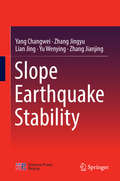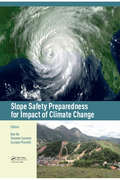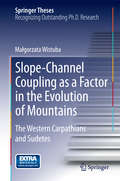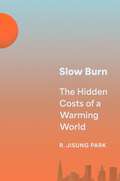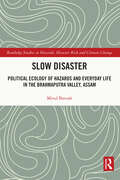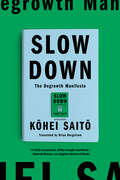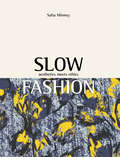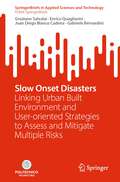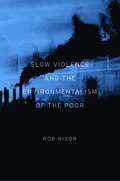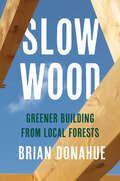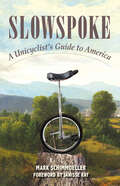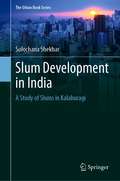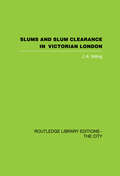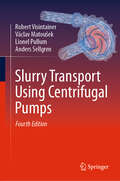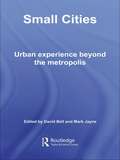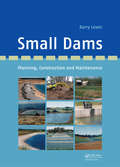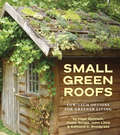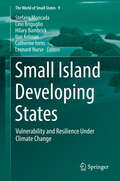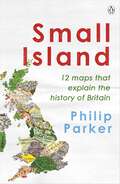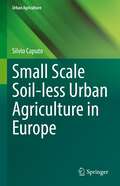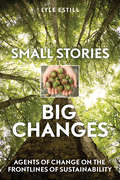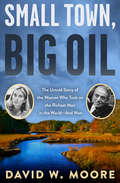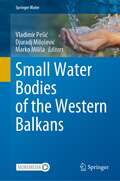- Table View
- List View
Slope Earthquake Stability
by Yang Changwei Zhang Jingyu Lian Jing Yu Wenying Zhang JianjingThis book begins with the dynamic characteristics of the covering layerbedrock type slope, containing monitoring data of the seismic array, shaking table tests, numerical analysis and theoretical derivation. Then it focuses on the landslide mechanism and assessment method. It also proposes a model that assessing the hazard area based on the field investigations. Many questions, exercises and solutions are given. Researchers and engineers in the field of Geotechnical Engineering and Anti-seismic Engineering can benefit from it.
Slope Safety Preparedness for Impact of Climate Change
by Ken Ho Luciano Picarelli Suzanne LacasseMany countries are increasingly threatened by major landslide disasters and fatalities due to extreme weather events which have major implications for public safety and the sustainability of infrastructure and the built environment. A further increase in such a trend could come from climate change. This book helps to fill in the gap due to the fact that landslide hazards are commonly not covered under the policy debate on climate change. The book highlights the importance of raising awareness to the challenges of landslide hazards due to climate impact. It provides a holistic frame for understanding the key issues and new tools that could be used to assess and manage the landslide risks. The book gathers contributions from 21 countries and regions in the form of national reports or summaries with respect to four key aspects: a) the methods used for evaluating changing weather and changing landslide patterns; b) the changing weather patterns; c) the changing landslide patterns and hazard scenarios; d) the applications to risk management and the formulation of adaptation measures. Recommendations are made for enhanced preparedness and resilience. Improved crisis management and areas for future work are suggested.
Slope Stochastic Dynamics
by Yu Huang Min Xiong Liuyuan ZhaoThis book provides a new framework for analysis of slope nonlinear stochastic seismic dynamic response based on the new theoretical tool of stochastic dynamics. The coupling effects of uncertainty of geological parameters, strong dynamic nonlinearity, and randomness of ground motion are considered in the process of the seismic dynamic stability assessment of slope. In this book, an intensity frequency non-stationary stochastic ground motion model based on time-domain stochastic process description is preliminarily established to characterize the randomness of earthquakes. The spatial distribution random field model of geotechnical parameters is established to describe the time-space variability of geotechnical parameters. Based on the basic theory of stochastic dynamics, the seismic stability performance evaluation method of slope is established. The slope seismic dynamic model test based on large complex shaking table is performed to verify and modify the proposed framework and method. This book sheds new light on the development of nonlinear seismic stochastic dynamics and seismic design of slope engineering.
Slope-Channel Coupling as a Factor in the Evolution of Mountains
by Małgorzata WistubaIn this thesis, coupling between the delivery of slope material into valley floors and river erosion is considered to be a factor in the evolution of mid-altitude, forested mountains. Analyses of slope-channel interactions were made in ten small catchments with particular emphasis on landsliding-erosion feedback. An original, new dendrogeomorphic approach was applied to determine the cyclic occurrence of landsliding and erosion during recent decades. The results of dendrochronological studies show that the processes studied are strongly interdependent. Fluvial erosion can trigger landsliding by undermining slope bases. Landsliding can intensify erosion by delivering slope material into valley floors. The results of dendrochronological studies have permitted a better understanding of the relief observed in areas where landslides and erosion are coupled. A scheme was established which describes the importance of coupling in the evolution of mid-mountain landscape.
Slow Burn: The Hidden Costs of a Warming World
by R. Jisung ParkHow the subtle but significant consequences of a hotter planet have already begun—from lower test scores to higher crime rates—and how we might tackle them todayIt&’s hard not to feel anxious about the problem of climate change, especially if we think of it as an impending planetary catastrophe. In Slow Burn, R. Jisung Park encourages us to view climate change through a different lens: one that focuses less on the possibility of mass climate extinction in a theoretical future, and more on the everyday implications of climate change here and now.Drawing on a wealth of new data and cutting-edge economics, Park shows how climate change headlines often miss some of the most important costs. When wildfires blaze, what happens to people downwind of the smoke? When natural disasters destroy buildings and bridges, what happens to educational outcomes? Park explains how climate change operates as the silent accumulation of a thousand tiny conflagrations: imperceptibly elevated health risks spread across billions of people; pennies off the dollar of productivity; fewer opportunities for upward mobility.By investigating how the physical phenomenon of climate change interacts with social and economic institutions, Park illustrates how climate change already affects everyone, and may act as an amplifier of inequality. Wealthier households and corporations may adapt quickly, but, without targeted interventions, less advantaged communities may not.Viewing climate change as a slow and unequal burn comes with an important silver lining. It puts dollars and cents behind the case for aggressive emissions cuts and helps identify concrete steps that can be taken to better manage its adverse effects. We can begin to overcome our climate anxiety, Park shows us, when we begin to tackle these problems locally.
Slow Disaster: Political Ecology of Hazards and Everyday Life in the Brahmaputra Valley, Assam (Routledge Studies in Hazards, Disaster Risk and Climate Change)
by Mitul BaruahThis book presents a fascinating, ethnographic account of the challenges faced by communities living in Majuli, India, one of the largest river islands in the world, which has experienced immense socio-environmental transformations over the years, processes that are emblematic of the Brahmaputra Valley as a whole. Written in an engaging style, full of the author's insider perspectives, this insightful volume explores the processes of flooding and riverbank erosion in Majuli, including re-configuration of the island’s geographies, loss of local livelihoods, and large-scale displacement of the population. The book begins with an examination of the physical geography of Majuli and its ecological complexities, leading to discussion on the role of the state in water governance and hazard management, as well as popular resistance by the rural communities on the island. The book focuses on livelihoods as a way of offering economic context to living in challenging environmental conditions and examines the interactions between the state and a whole host of non-state actors, and the everyday, arbitrary functioning of the bureaucracy in a hazardscape. This volume is an invaluable resource for scholars interested in political ecology of hazards and vulnerability, water and hydraulic infrastructure, rural livelihoods and agrarian questions, state theorizations, island studies, and resistance and social movements, as well as those with an interest in northeast India more generally across various disciplines.
Slow Down: The Degrowth Manifesto
by KOHEI SAITO"[A] well-reasoned and eye-opening treatise . . . [Kohei Saito makes] a provocative and visionary proposal." —Publishers Weekly, (starred review)"Saito&’s clarity of thought, plethora of evidence, and conversational, gentle, yet urgent tone . . . are sure to win over open-minded readers who understand the dire nature of our global. . . . A cogently structured anti-capitalist approach to the climate crisis." —Kirkus Reviews (starred review)Why, in our affluent society, do so many people live in poverty, without access to health care, working multiple jobs and are nevertheless unable to make ends meet, with no future prospects, while the planet is burning?In his international bestseller, Kohei Saito argues that while unfettered capitalism is often blamed for inequality and climate change, subsequent calls for &“sustainable growth&” and a &“Green New Deal&” are a dangerous compromise. Capitalism creates artificial scarcity by pursuing profit based on the value of products rather than their usefulness and by putting perpetual growth above all else. It is therefore impossible to reverse climate change in a capitalist society—more: the system that caused the problem in the first place cannot be an integral part of the solution. Instead, Saito advocates for degrowth and deceleration, which he conceives as the slowing of economic activity through the democratic reform of labor and production. In practical terms, he argues for:the end of mass production and mass consumptiondecarbonization through shorter working hours the prioritization of essential labor over corporate profitsBy returning to a system of social ownership, he argues, we can restore abundance and focus on those activities that are essential for human life, effectively reversing climate change and saving the planet.
Slow Fashion: Aesthetics Meets Ethics
by Safia MinneySlow Fashion offers creatives, entrepreneurs, and ethical consumers alike a glimpse into the innovative world of the eco-concept store movement, sustainable design, and business that puts people, livelihoods, and sustainability central to everything they do. <p><p> Safia Minney argues that the future of brick and mortar retail is in the best in fair trade, sustainability, and organic products, together with vintage and second hand goods and local produce. Restorative economics, the well-being of our planet, and our bodies and minds can be inspired by this growing sector, one that is shaping big business.This book curates pioneering people and projects that will inspire you to be part of the change. International names include Livia Firth, Zandra Rhodes, and Lily Cole. American change-makers include Andrew Morgan, filmmaker (The True Cost, a ground-breaking documentary that asks us each to consider who pays the price for our clothing), and Dana Geffner (Fair World Project). <p> With full color photography and elegant design, Slow Fashion profiles the people bringing the alternatives to the mainstream: designers, labels, and eco-concept stores across the world; fair trade producers; campaigns that are re-designing the fashion economy; and the fibers and fabrics which are making a difference.
Slow Onset Disasters: Linking Urban Built Environment and User-oriented Strategies to Assess and Mitigate Multiple Risks (SpringerBriefs in Applied Sciences and Technology)
by Gabriele Bernardini Graziano Salvalai Enrico Quagliarini Juan Diego Blanco CadenaThe book provides an overview of the Slow Onset Disasters (SLOD) in the urban built environment discussing potential strategies to assess and mitigate multiple climate change related risks. Climate change evidence has been reported in the last decades, suggesting that the anthropogenic activities are accelerating these changes towards a warmer and more polluted environment. In this context, SLODs have been linked to climate change related disasters and have been stated to have a higher impact risk within dense built environment (BE). Therefore, the book presents a description of the most relevant SLODs, their significance, and confluence, the way in which scientists and entities are monitoring their progression at different scales, a structured risk assessment strategy and the deconstruction of the BE characteristics that make it more prone to SLODs risk. In addition, it highlights the necessity of adapting the traditional risk assessment methods, to account for different vulnerability types, including the morphology and materiality of the BE, and the BE users’ characteristics. In fact, individual features influence users’ responses and tolerance to environmental stressors, because of age, health, gender, habits, and behaviour, thus impacting the users’ vulnerability. Exposure can then amplify these issues, since it defines the number of users that can be effectively affected by the SLOD. Starting from this perspective, the book first traces literature-based correlations between individual features, use behaviour, and individual response to the SLOD-altered open spaces. Then, a novel methodology, to quantify the variations of users’ vulnerability and exposure, is offered, to support designers in quickly defining input scenarios for risk assessment and mitigation. Lastly, it demonstrates, through a case study, the SLOD risk assessment framework proposed and the evaluation of the efficacy of risk mitigation strategies.
Slow Violence and the Environmentalism of the Poor
by Rob Nixon“Slow violence” from climate change, toxic drift, deforestation, oil spills, and the environmental aftermath of war takes place gradually and often invisibly. Rob Nixon focuses on the inattention we have paid to the lethality of many environmental crises, in contrast with the sensational, spectacle-driven messaging that impels public activism today.
Slow Wood: Greener Building from Local Forests (Yale Agrarian Studies Series)
by Brian DonahueA radical proposal for healing the relationship between humans and forests through responsible, sustainable use of local and regional wood in home building American homes are typically made of lumber and plywood delivered by a global system of ruthless extraction, or of concrete and steel, which are even worse for the planet. Wood is often the most sustainable material for building, but we need to protect diverse forests as much as we desperately need more houses. Brian Donahue addresses this modern conundrum by documenting his experiences building a timber frame home from the wood growing on his family farm, practicing &“worst first&” forestry. Through the stories of the trees he used (sugar maple, black cherry, black birch, and hemlock), and some he didn&’t (white pine and red oak), the book also explores the history of Americans&’ relationship with their forests. Donahue provides a new interpretation of the connection between American houses and local woodlands. He delves into how this bond was broken by the rise of a market economy of industrial resource extraction and addresses the challenge of restoring a more enduring relationship. Ultimately, this book provides a blueprint and a stewardship plan for how to live more responsibly with the woods, offering a sustainable approach to both forestry and building centered on tightly connected ecological and social values.
Slowspoke: A Unicyclist's Guide to America
by Mark SchimmoellerWhy a unicycle? Why a cross-country trip? Why leave a prominent New York magazine and return to the simple life in Kentucky?Reminiscent of classic literary travelogues, Mark Schimmoeller&’s Slowspoke: A Unicyclist&’s Guide to America takes readers on an inward, emotional journey as he inches across landscapes and communities from North Carolina to Arizona.Schimmoeller became inspired by his unicycle as an adolescent. It taught him that rushing—whether down the driveway or toward adulthood—would cause a fall, and so, instead of accepting the speeding, straight line that de-fines modern American life, he adopted his single wheel&’s wayward rhythms.Written with poise and humor, Slowspoke is more than a cross-country trip on a unicycle; it&’s a meditation on a playful, recalcitrant slowness that is increasingly rare in a culture obsessed with acceleration. At times ach-ing and other times joyful, Schimmoeller intersperses recollections of his journey with vignettes of his present-day, off-the-grid homesteading with his wife in Kentucky and their efforts to save an old-growth forest.Schimmoeller&’s personal journey will resonate with anyone who has slowed down to experience life at a unicycle&’s speed or who longs to do so, who has fallen in love or searched for it, or who has treasured tall trees or mourned their loss.
Slum Development in India: A Study of Slums in Kalaburagi (The Urban Book Series)
by Sulochana ShekharThis book is an earnest effort in understanding the slums and their needs by taking a case study of Kalaburagi, India. This study aims to contribute sustainable methodologies to advance the living conditions of slum dwellers and for better execution of slum policies. The core objectives are: 1) mapping the existing slums of Kalaburagi (formerly Gulbarga) city using slum ontology from very high-resolution data and validating the slum map through ground survey and using reliable data; 2) developing a model to understand the factors which are responsible for the present growth as well as to predict the future growth of slums; 3) estimating the housing demand of urban poor and suggesting a suitable site for the rehabilitation program; and 4) suggestions for the better intervention of government policies with special reference to in-situ program.Urban is the future, and slums are its reality. Sustainable development goals are directly and indirectly concerned about the increasing urbanization and the slums. Housing the urban poor and affordable housing to all are the national missions. Practically making these plans successful depends on a deep understanding of urban issues and proper methodology and technology to handle it. The participatory slum mapping, cellular automata slum model, housing demand analysis, and the spatial decision support system demonstrated in the book help in monitoring and managing the slums and thus lead towards a slum-free India.
Slurry Transport Using Centrifugal Pumps
by Václav Matoušek Robert Visintainer Lionel Pullum Anders SellgrenBased on the industry leading short course “Transportation of Solids using Centrifugal Pumps,” founded by Dr. Kenneth Wilson and Graeme Addie, and hosted by the GIW Industries Hydraulic Laboratory, this expanded fourth edition has been extensively updated by the international team of engineers and authors who inherited this legacy and continue its development to the present day. Focusing on the hydraulic design of slurry pipelines, the pumps that power them, and the interactions between pumps and systems, it retains the classroom tested balance of theoretical development and practical engineering which have made it a slurry transport classic. The topics covered are important to slurry system engineers for the optimization of new designs, as well as the operators of existing systems, who may need to calculate and plan for changing conditions from day to day. Updates to the fourth edition include:· Careful formulation of the theoretical concepts, providing greater clarity of slurry flow dynamics, including a new chapter on the principles and characterization of slurry flows. · Expansion of the 4-Component Models for settling slurry pipeline flow and pump solids effect, based on an extensive series of full-sized tests.· An expanded treatment of complex slurries, including a broader discussion of non-Newtonian fluids and their interaction with coarse particles. · A new chapter on test methods, presenting an overview of slurry system instrumentation, modern techniques for characterizing slurry rheology, and practical advice for planning and executing a slurry test.· An overview of advances in the computational modeling of slurries, including an in-depth parametric study of slurry pump wear and operating cost. The authors highlight methods for achieving energy efficiency, which are crucial to the effective use of scarce resources, given the foundational role of slurry transport systems in the energy intensive industries of mining and dredging. Key concepts are supported with case studies and worked examples. Slurry Transport Using Centrifugal Pumps, fourth edition, is both methodical and in-depth. It is ideal as a teaching tool for classroom or self-directed learning domains, and valuable as a design guide for engineer practitioners at all experience levels.
Small Cetaceans of Japan: Exploitation and Biology
by Toshio KasuyaThis book summarizes and analyzes the biology, ecology, exploitation and management of small cetaceans in Japan. It describes the various types of cetacean fisheries in Japan and their historical development, the life histories and ecologies of the main species involved, and the history and problems of conservation and management. The data show that in some cases the number of small cetaceans harvested exceed sustainable limits and have led to depletion of populations. The book provides a case study of what can go wrong when the needs of industry and conservation collide. The descriptions of life history and ecology are relevant to issues of conservation and management, not just for cetaceans, but for all fisheries around the world.
Small Cities: Urban Experience Beyond the Metropolis (Questioning Cities)
by David Bell Mark JayneUntil now, much research in the field of urban planning and change has focused on the economic, political, social, cultural and spatial transformations of global cities and larger metropolitan areas. In this topical new volume, David Bell and Mark Jayne redress this balance, focusing on urban change within small cities around the world. Drawing together research from a strong international team of contributors, this four part book is the first systematic overview of small cities. A comprehensive and integrated primer with coverage of all key topics, it takes a multi-disciplinary approach to an important contemporary urban phenomenon. The book addresses: political and economic decision making urban economic development and competitive advantage cultural infrastructure and planning in the regeneration of small cities identities, lifestyles and ways in which different groups interact in small cities. Centering on urban change as opposed to pure ethnographic description, the book’s focus on informed empirical research raises many important issues. Its blend of conceptual chapters and theoretically directed case studies provides an excellent resource for a broad spectrum of undergraduate and postgraduate students, as well as providing a rich resource for academics and researchers.
Small Dams: Planning, Construction and Maintenance
by Barry LewisSmall Dams: Planning, Construction and Maintenance has been written to provide a practical approach and guide to determining catchment yield and the amount of water required in a dam, advising on selecting and working with engineers and contractors, as well as outlining the cause of dam failures and how to remedy problems quickly. It also covers re
Small Green Roofs: Low-Tech Options for Greener Living
by John Little Edmund C. Snodgrass Nigel Dunnett Dusty GedgeUntil now, the green roof movement has been limited to large-scale, professional endeavors and public buildings. But homeowners everywhere are catching onto the benefits of a green roof—water conservation, energy savings, and storm water management. In Small Green Roofs authors Dunnett, Gedge, Little, and Snodgrass profile ordinary homeowners who scaled green roofs down to the domestic level.Small Green Roofs is the first book to focus on small-scale and domestic green roofs. More than forty profiles of small and domestic-scale projects of all shapes and sizes include green roofs on sheds, garden offices, studios, garages, houses, bicycle sheds, and other small structures, as well as several community projects. For each project, details are given for design, construction, and installation, as well as how-to tips on how the roof was planted and cared for. For readers looking for inspiration when hiring a contractor or taking the adventurous step of building their own, Small Green Roofs provides the knowledge and encouragement to make it possible.
Small Island Developing States: Vulnerability and Resilience Under Climate Change (The World of Small States #9)
by Ilan Kelman Lino Briguglio Stefano Moncada Hilary Bambrick Catherine Iorns Leonard NurseThis book explores how vulnerable and resilient communities from SIDS are affected by climate change; proposes and, where possible, evaluates adaptation activities; identifies factors capable of enhancing or inhibiting SIDS people’s long-term ability to deal with climate change; and critiques the discourses, vocabularies, and constructions around SIDS dealing with climate change. The contributions, written by well-established scholars, as well as emerging authors and practitioners, in the field, include conceptual papers, coherent methodological approaches, and case studies from the communities based in the Caribbean Sea and the Indian, Atlantic, and Pacific Oceans. In their introduction, the editors contextualise the book within the current literature. They emphasise the importance of stronger links between climate change science and policy in SIDS, both to increase effectiveness of policy and also boost scholarly enquiry in the context of whose communities are often excluded by mainstream research. This book is timely and appropriate, given the recent commission by the Intergovernmental Panel on Climate Change (IPCC) of a Special Report that aims at addressing vulnerabilities, “especially in islands and coastal areas, as well as the adaptation and policy development opportunities” following the Paris Agreement. Coupled with this, there is also the need to support the policy community with further scientific evidence on climate change–related issues in SIDS, accompanying the first years of implementation of the United Nations Sustainable Development Goals.
Small Island: 12 Maps That Explain The History of Britain (New History of Britain #1)
by Philip ParkerDiscover the 12 crucial moments in Britain's past that will answer the greatest questions for our future in this richly insightful and fascinating history'A richly entertaining canter through the country's past. Engrossing' INDEPENDENT___________What is Britain?Where lie its boundaries?Why are they always changing?Are we a small island or a big idea?What will we look like next?In Small Island: 12 Maps that Explain the History of Britain, Philip Parker answers these and other crucial questions about this country and its peoples.By pondering our intertwined geography and history, he shows how the past has made Britain and how we might yet shape its future.
Small Scale Soil-less Urban Agriculture in Europe (Urban Agriculture)
by Silvio CaputoThis Monograph focuses on the new approaches that urban agriculture offers to grow food in cities. The author paints a dynamic picture of soil-less and indoor techniques that are currently emerging. A growing number of small scale community-led and entrepreneurial initiatives are using such techniques for diverse objectives: to increase resource efficiency; to strengthen food security; to educate and inform or to exploit new market opportunities. The described studies demonstrate how technologies that are typically used in high-tech food production can also be harnessed in small projects to generate social and economic benefits at a local level. The author puts a focus on three aspects: to outline the context within which small scale soil-less urban agriculture is developing in Europe; to give an overview of the state-of-the-art of projects focusing on this area through case study analysis and to elaborate on emerging questions. Such questions include: is the use of soil-less urban agriculture changing the relationship with, and perception of, what is natural and sustainable for urban farmers and small enterprises working in this sector? What is the perceived potential of these soil-less and indoor forms of urban agriculture to meet environmental, social and economic goals? By answering these and other questions, the volume is a valuable resource for researchers in agriculture and sustainability, as well as urban farmers.
Small Stories, Big Changes: Agents of Change on the Frontlines of Sustainability
by David W. Orr Lyle EstillA remarkable cast of characters inhabit the pages of this book. Meet Tim Toben, who developed a high rise with the lowest energy consumption of any building in the southeastern United States, was foreclosed upon, and lost millions in the process. Gary Phillips held the line against real estate developers in Chatham County and was run out of office for his efforts. Elaine Chiosso has been protecting her watershed by fighting on behalf of the Haw River for twenty-eight years.Unflinchingly honest and compulsively readable, Small Stories, Big Changes provides an intimate look at the personal experience of being a pioneer in the sustainability movement, laying bare the emotional, spiritual, and financial impact of a life lived in the service of change. Activist, farmer, publisher, philosopher or entrepreneur; each writer has a unique personal tale to tell.Small Stories, Big Changes is a book written by ordinary people doing extraordinary things; whose lives have been transformed by their willingness to commit themselves unreservedly to the creation of a better world. Empowering, hopeful, and inspiring, this rich tapestry of voices from the vanguard of change is a must-read for anyone dreaming of a brighter future and seeking a counterbalance to a canon of work that is laced with doom and gloom.Lyle Estill is the president and co-founder of Piedmont Biofuels and the author of Industrial Evolution, Small is Possible, and Biodiesel Power. He has won numerous awards for his commitment to sustainability, outreach, community development, and leadership.
Small Town, Big Oil: The Untold Story of the Women Who Took on the Richest Man in the World—and Won
by David W. MooreHow three New Hampshire women triumphed over an oil billionaire: &“A very timely reminder that when we fight we often win.&”—Bill McKibben Never underestimate the underdog. In 1973, Greek oil shipping magnate Aristotle Onassis—husband of President John F. Kennedy&’s widow, Jacqueline, and arguably the richest man in the world—proposed to build an oil refinery on the narrow New Hampshire coast, in the town of Durham. At the time, it would have cost $600 million to build and was expected to generate 400,000 barrels of oil per day, making it the largest oil refinery in the world. The project was vigorously supported by the governor, Meldrim Thomson, and by William Loeb, the notorious publisher of the only statewide newspaper, the Manchester Union Leader. But three women vehemently opposed the project—Nancy Sandberg, the town leader who founded and headed Save Our Shores; Dudley Dudley, the freshman state rep who took the fight to the state legislature; and Phyllis Bennett, the publisher of the local newspaper that alerted the public to Onassis&’ secret acquisition of the land. Small Town, Big Oil is the story of how the residents of Durham, led by these three women, out-organized, out-witted, and out-maneuvered the governor, the media, and the Onassis cartel to hand the powerful Greek billionaire the most humiliating defeat of his business career, and spare the New Hampshire seacoast from becoming an industrial wasteland. &“Activists and organizers will find lots of ideas and inspirations in this book's detailed account of an epic battle.&”—Bill McKibben &“[An] apt handbook on the power of the people.&”—Providence Journal
Small Water Bodies of the Western Balkans (Springer Water)
by Vladimir Pešić Djuradj Milošević Marko MilišaThe small water bodies such as headwater streams, springs, ditches, small lakes, and ponds are critical to maintaining freshwater biodiversity. This is especially true for Dinaric karst, where they are often the only water bodies present. However, despite their importance, they remain widely overlooked and excluded from government policies like the EU Water Framework Directive. This book includes information on different aspects of these essential but still neglected habitats. This book intends to be of interest to a wide range of audiences, from researchers and conservationists to the public and decision-makers.
